“I was very happy when Stephen came to me with the idea for a book on Indonesian postcards and though “Former Points of View” is now long out of print the publication will forever be a pioneering and landmark work in the field of Indonesian deltiology. (I’m so glad that Scott Merrillees took the torch from Stephen and has produced additional and wonderful titles.)“
John Hubert McGlynn
Before leaving on a long-term assignment as Foreign Service officer with the U. S. Agency for International Development (USAID), I visited bookstores, map shops, and old postcard shows to begin my documentation of the country in which I was to live for four years, in this case Indonesia.
For the purposes of this blog post, the map shop will take the form of www.freeworldmaps.net and Wikipedia data. Indonesia is an archipelago and the largest country in Southeast Asia, composed of 14,504 islands and covering four time zones. I lived in the capital, Jakarta (that used to be called Batavia) on the island of Java. My work as head of the education and training sector took me to mainly Sumatra and Kalimantan islands. I visited only 12 islands during my four-year stay. Only 8,844 islands are named. Only 922 are permanently inhabited.
This post focusses on Padang in the Minang or Minangkabau region in Sumatra, the third largest island in the country, 184,954 square miles. In the Minang language, Minang means “victorious” and kabau means “buffalo.” Minangkabau houses are famous for the ridge beams that sweep up to a sharp point at both ends, evoking water buffalo horns. The Minangkabau ethnic group is distinctive as it is the only matrilineal culture in the Islamic world.
Fig. 1. Map of Indonesia (in green), with Sumatra Island on the left
Fig. 2. Map of Minangkabau region in west-central Sumatra
At a “paper show” in Hartford, Connecticut, after buying several books on Indonesia, I moved to the postcard section. I found over fifty 1930-vintage sepia postcards from Indonesia for sale. Many had perforations along one side, indicating they had come from a detachable pack. In the lower left-hand corner most had an insignia that read KPM, the initials of the Koninklijke Paketvaart-Maatschappij (the Royal Dutch Packet Company), the shipping line that served passengers between Holland and the Dutch East Indies. The cards, produced by KPM for sale on its liners, were in mint condition, none having been sent through the mails. My guess was that they had been bought by an American tourist in the 1930s who had read about “the last paradise on earth.” The cards had been taken 10,000 miles to the eastern U.S., where they had lain in a shoebox for decades, being relegated to an attic, before being sold to an antique or flea-market dealer possibly because none of the grandchildren was interested in seeing what interesting information they might contain. At least they had not been pitched into the dust bin, the fate of most postcards.
I offered the dealer half the asking price. He hesitated. Then he craned his neck to look into the snack bar off to one side of the showroom floor. “Ya, I guess so. The wife’s still over there eating, but she’ll kill me when she gets back.” So the $3 per card rate went down to $1.50 a pop. Not bad, I thought.
When I got home and laid out the postcards on the bed, separating them by island, I discovered 23 cards depicting scenes from Sumatra, 12 from Bali, 12 from Java, seven from Sulawesi, and three from Borneo. All this collecting took place before I arrived in-country for my long-term assignment. By then I had amassed over 200 old postcards of Indonesia. Less than half had any message on them or had been sent through the mail.
Fig. 3. Sepia postcard of two adjacent Minangkabau houses in Padang Panjang
Photo by Stephen Grant
Fig. 4. Reverse side of above postcard
Photo by Stephen Grant
I was excited about the prospect of showing people my newly acquired photographic evidence of what Indonesia looked like several decades earlier. I brought a handful of the postcards to my first Indonesian language lesson in Bandung (see Fig. 1., where Bandung is shown south of Jakarta on the island of Java) thinking that might be one way to develop vocabulary. As I handed her the stack to go through, my teacher Ibu (Mrs.) Leila Hasyim admitted she had never heard of anyone collecting old postcards. She leafed through the ancient views with curiosity. Then suddenly she drew in her breath and stiffened, She repeatedly stabbed at the house pictured (Fig. 2.) on one of the cards. “Rumah ini, rumah saya,” she finally gasped. She left the room in a dash and returned with a framed color picture removed from her living room wall. “This house is my house!” The skin on her arm was covered by goose flesh as she explained that this brightly painted wooden adat (traditional) house had been built by her family in Padang Panjang, West Sumatra in the 1870s. Although she possessed photos of her house in the 1950s, she had never seen a picture of it with a thatched palm roof. She knew that, starting in the early 1930s, a zinc roof had been put on. Together we studied the card. On the picture side, there was no identification, no writing at all. In the lower left corner an insignia. Leila figured it out, KPM. On the reverse side (Fig. 3.) on the upper left was the name of the postcard producer, the Koninklijke Paketvaart-Maatschappij (the Royal Dutch Packet Company). That explained the initials K.P.M. in a circle with a period after each. Printing on the message part of the card divulged the Indonesian island, Sumatra, the nearest city, Padang Pandjang (the newer spelling would eliminate the “j”), and the subject Adathuis or Native House. Padang figures in Fig. 1. You also notice the penciled asking price, $3.00 at the postcard show.
At any rate, I simply had to give Ibu Leila the card; but, luckily, later I was able to find another just the same. From that day on we started plotting when we might be able to visit her ancestral home. Several months later, my wife Annick Grant and I accompanied Leila Hasyim to Padang Panjang and took pictures of the house which was still in excellent condition.
Fig. 5. Ibu Leila’s family home (exterior) in Padang Panjang
Photo by Stephen Grant
It is noteworthy that the traditional house to the right on the postcard had not been preserved. When a relative who had grown up in that house saw the old postcard of it, she wept. My photograph of Ibu Leila’s house (Fig. 5.) reveals on the right two modern windows with blue-gray shutters in the modern house which replaced the adat home. Fig. 3, Fig. 5., and Fig. 6. ALL show the same house. The Power of a Postcard story appeared in the March, 1994 issue of the Indonesian in-flight magazine, GARUDA under the title, “Life in the Old Card Yet,” where my Bahasa (language) teacher and I are pictured standing in front of her house in Padang Panjang, Sumatra.
Fig. 6. “Life in the Old Card Yet,” GARUDA page 36
Fig. 7. “Life in the Old Card Yet,” GARUDA page 37
While we were visiting her in Padang Panjang, Ibu laid on a traditional Minang luncheon inside her home for her family, neighbors, and friends (Fig. 8.). The meal consisted of the main staple, rice, rendang (chunks of water buffalo meat stewed in coconut oil), gulai otak (cattle brain curry), ayam bakar (roasted chicken), terong (eggplant), telor belado (spicy chile sauce with eggs), cucumber, shrimp crackers, gulai tunjang (pig’s feet soup), ikan bakar gembung (barbecued fish), dendeng balado (beef jerky), cabe hijau (green chile), and bananas.
Fig. 8. Ibu Leila’s home (interior) during traditional Minangkabau luncheon
Photo by Stephen Grant
It so happened that we were invited to a Minangkabau wedding during the same visit. “Buffalo hats,” I learned, were worn by only young unmarried women, up through their teens. One of the girls in Figs. 9.–10. wears earrings and a necklace, the other not. The girl in Fig. 9. has a red-and-gold cloth over the middle of her buffalo hat, the other not.
Fig. 9. Minangkabau girl at a wedding
Photo by Stephen Grant
Fig. 10. Second Minangkabau girl at a wedding
Photo by Stephen Grant
Fig.11. Minangkabau girl contemplating water buffalo horn
Photo by Stephen Grant
Fig. 12. “House of a big Family Padang Highlands”
Photo by Stephen Grant
Fig. 13. Reverse side of “House of a big Family Padang Highlands”
Photo by Stephen Grant
Fig. 14. “House of a big Family Padang Highlands”
Photo by Stephen Grant
Fig. 15. Reverse side of “House of a big Family Padang Highlands”
Photo by Stephen Grant
Fig. 16. Minangkabau Cultural Center, Padang Panjang
Photo by Annick Grant
Fig. 17. Online image of Minangkabau Cultural Center in Padang Panjang todayged ceiling awaiting renovation 1998
Fig. 18. Indonesian language teacher and pupil
Photo by Annick Grant
Fig. 19. Book Launch in Jakarta of Former Points of View:
Postcards and Literary Passages from Pre-Independence Indonesia (a
In September 1995, Ibu Leila came to Jakarta to attend the book launch of my second postcard book, Former Points of View: Postcards and Literary Passages from Pre-Independence Indonesia. Jakarta, Indonesia: LONTAR, 1995. She is pictured with (on far left) Yudhi Soerjoatmodjo, curator of Galeri Foto Jurnalistik Antara in Jakarta, and (talking with me) Prof. Dr. Emil Salim, Minister of Environment, who was from West Sumatra, who welcomed invitees to the book launch and accompanying postcard exhibition with co-sponsor Yayasan Lontar.
Fig. 20. Book Launch in Jakarta of Former Points of View:
Postcards and Literary Passages from Pre-Independence Indonesia (b)
Fig. 21. Greetings from Jakarta by Scott Merrillees, title page
Photo by Stephen Grant
Fig. 22. Padang Your Old History by Rusli Amran, title page
Photo by Stephen Grant
Here is a second title page of a book about Indonesia, but this one by an Indonesian, a Sumatran, and about Sumatra.
“For Stephen Grant, Your collection of old pictures of Indonesia is indeed extraordinary,
From the author, Rusli Amran Jak, 19 – XII –1993″
Padang Your Old History 2nd Edition – more complete Publisher: CV Yasaguna
I would like to end this Sumatran post with a concluding photograph.
Fig. 23. Three Authors Dine at Restaurant “Memories” in Jakarta 1995
The first paragraph of this post cites the figure of 14,504 islands in the Indonesian archipelago. The last paragraph quotes the figure of 6,656 restaurants in Jakarta; one of them is/was “Memories,” the only one whose principal decorative feature is that Indonesian picture postcards cover every wall. One day in 1995 three authors of different nationalities––Indonesian, Australian, and American––lunched there. During their conversation, they realized that their ages were separated by scores, or twenty-year increments. They were 35, 55, and 75 years old.
Rusli Amran was an expert regarding the Padri War, the longest and most monumental war of the Minang people against the Dutch. He is author of six books on West Sumatra published between 1981 and 1996.
Stephen Grant is author of five books––two biographies and three books on old picture postcards published in Guinea, Indonesia, and El Salvador—— published between 1991 and 2014.
Scott Merrillees is author of three books on old picture postcards of Jakarta (2) and Melbourne (1) published between 1996 and 2012, with a fourth book—on 500 Indonesian postcards—expected out soon Insha’Allah!
COMMENTS:
10 Comments
Submit a Comment
CONNECT

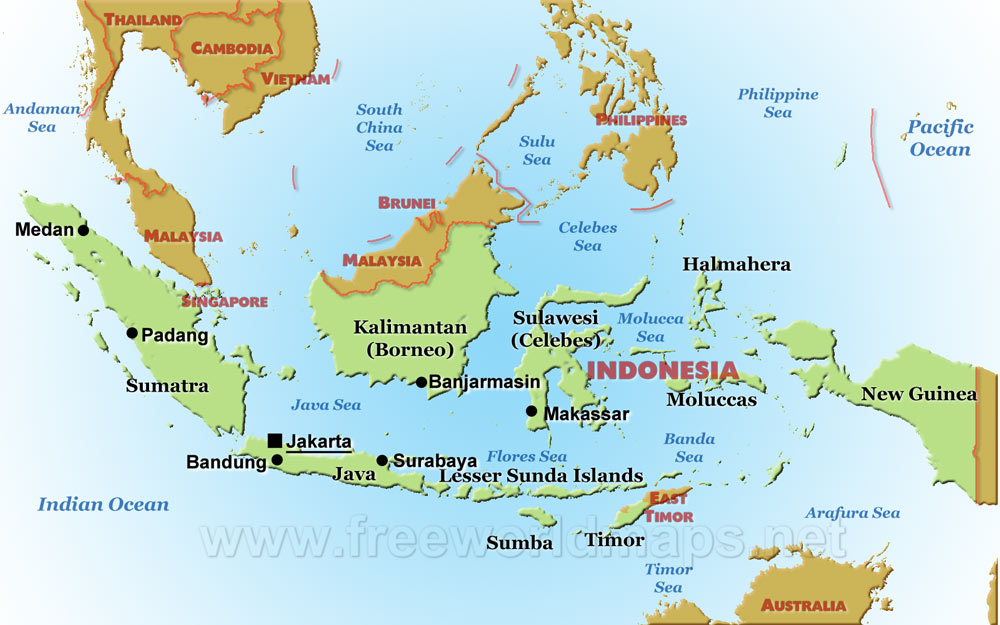
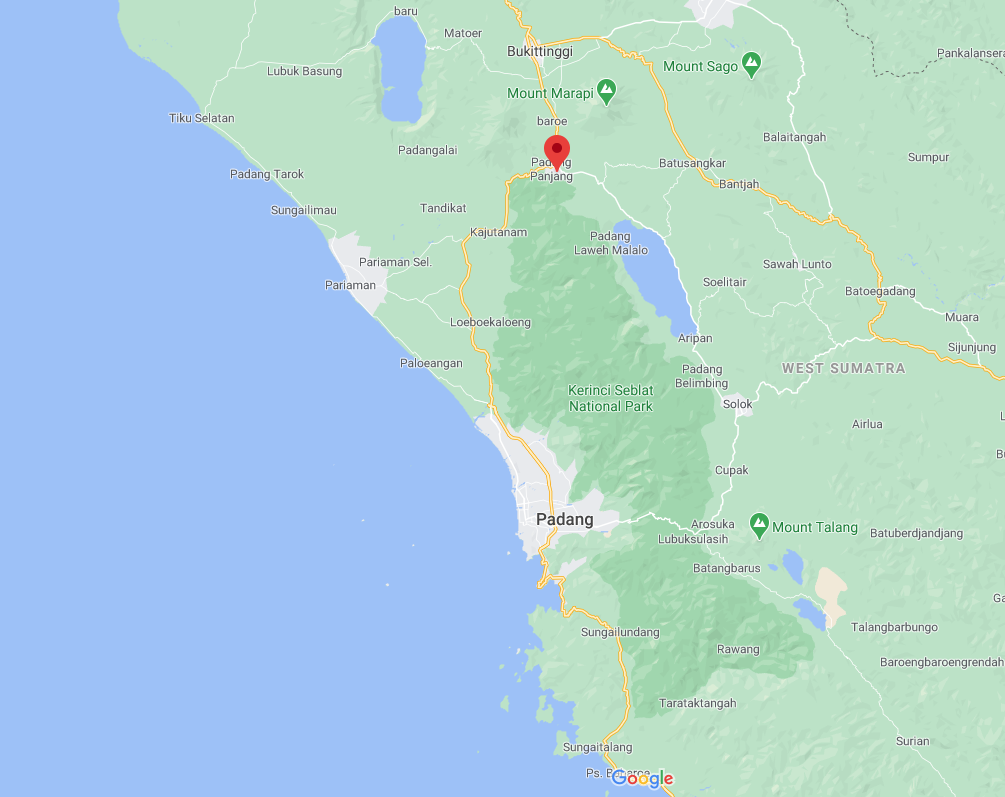
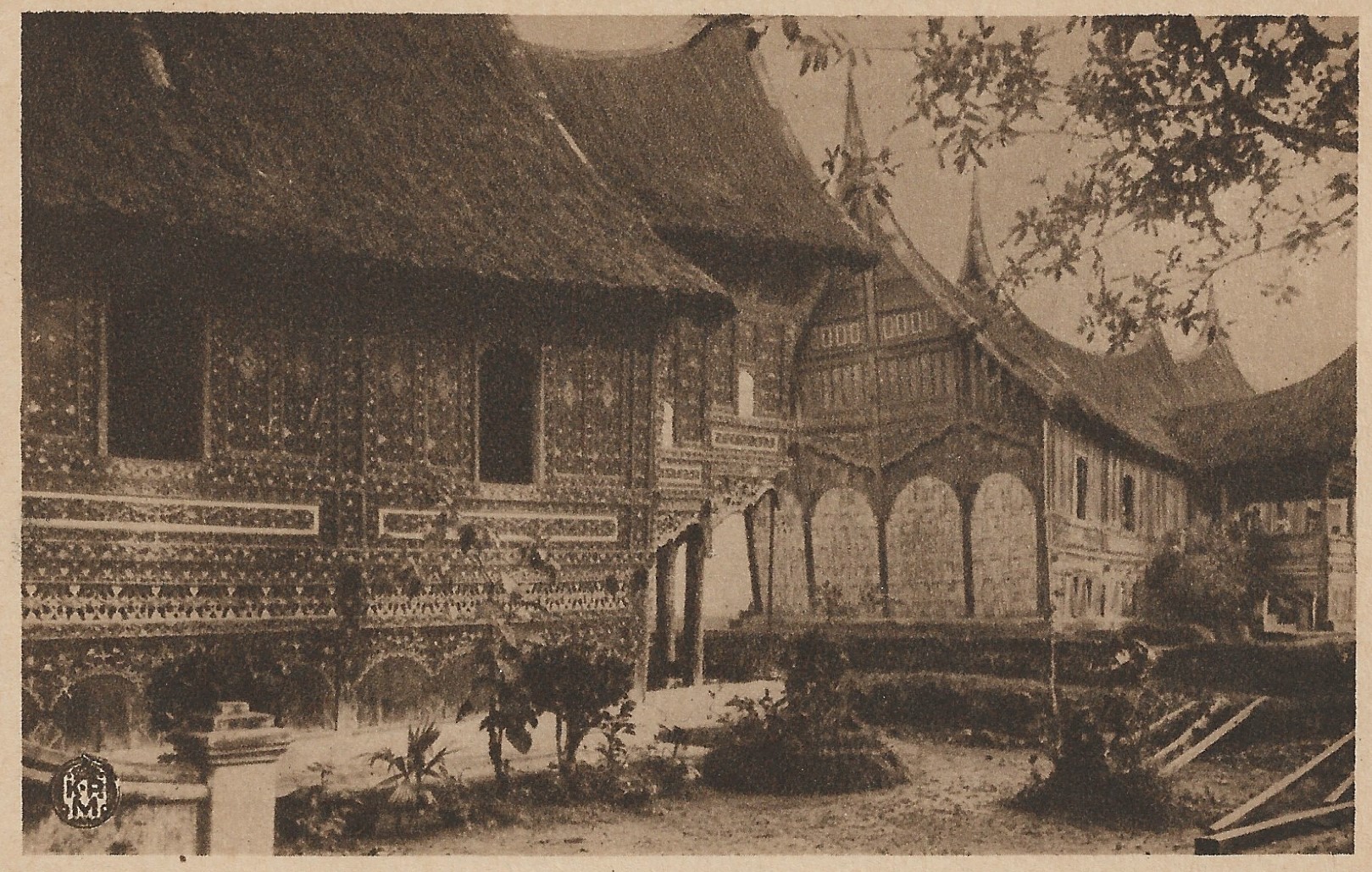
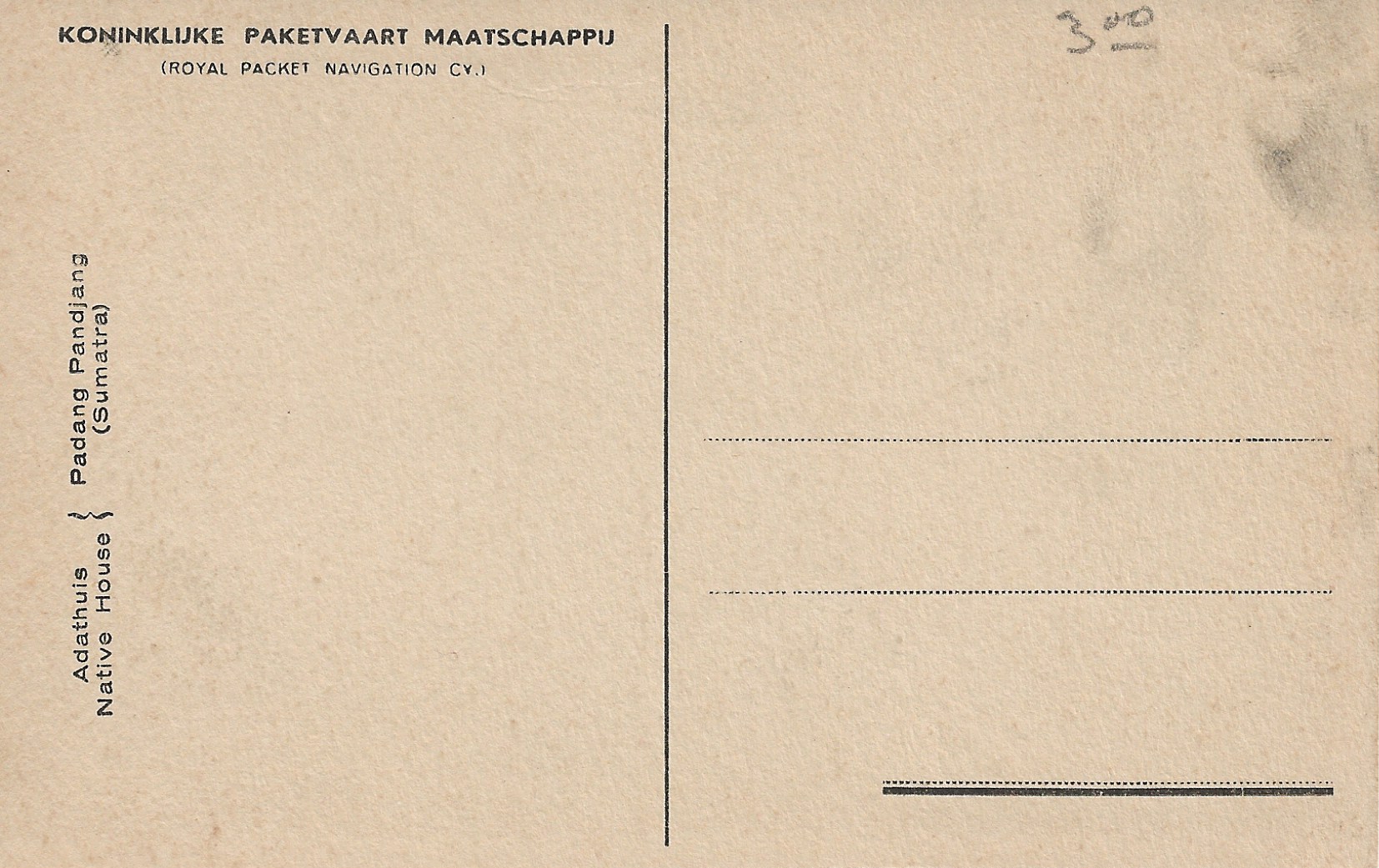
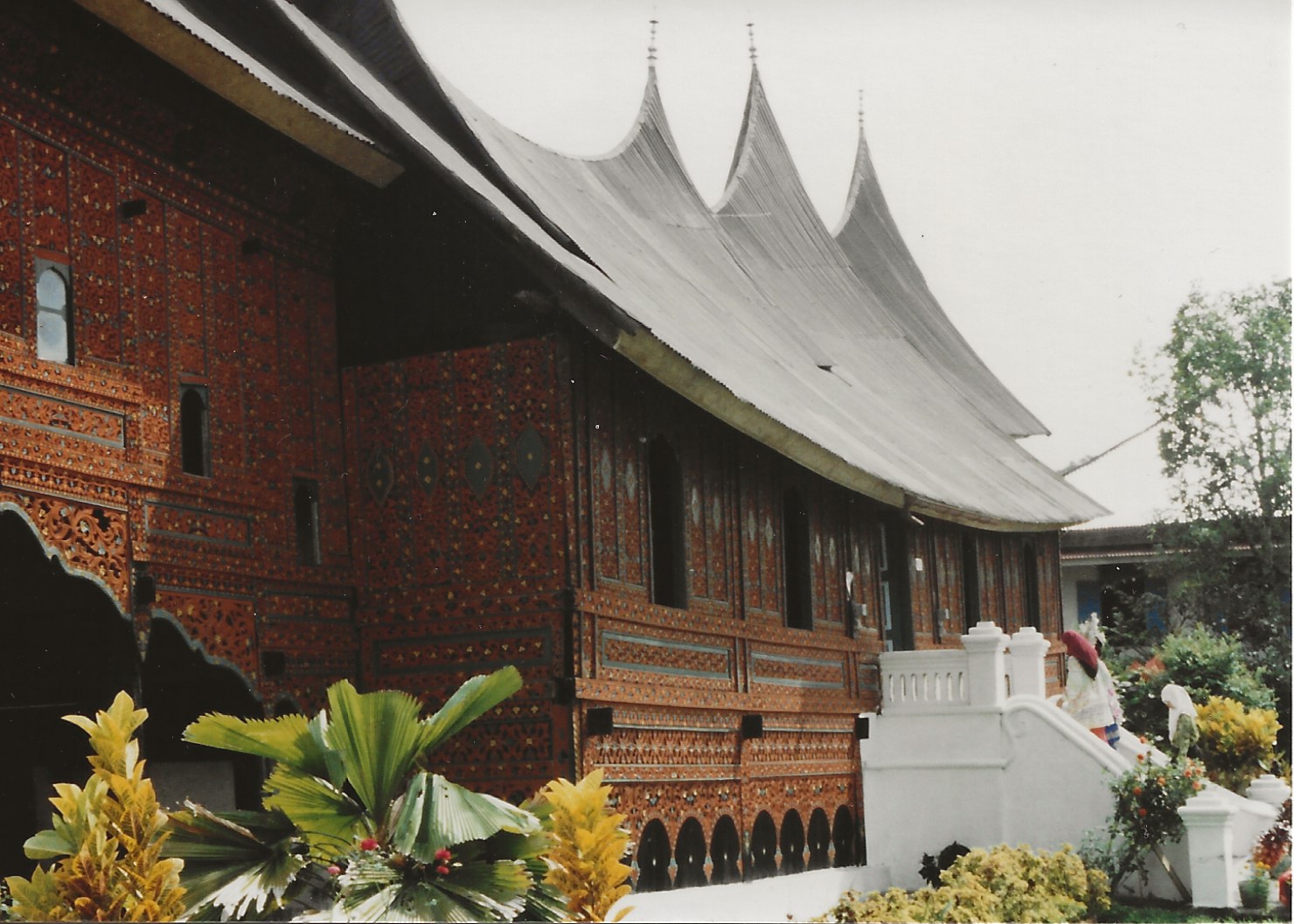
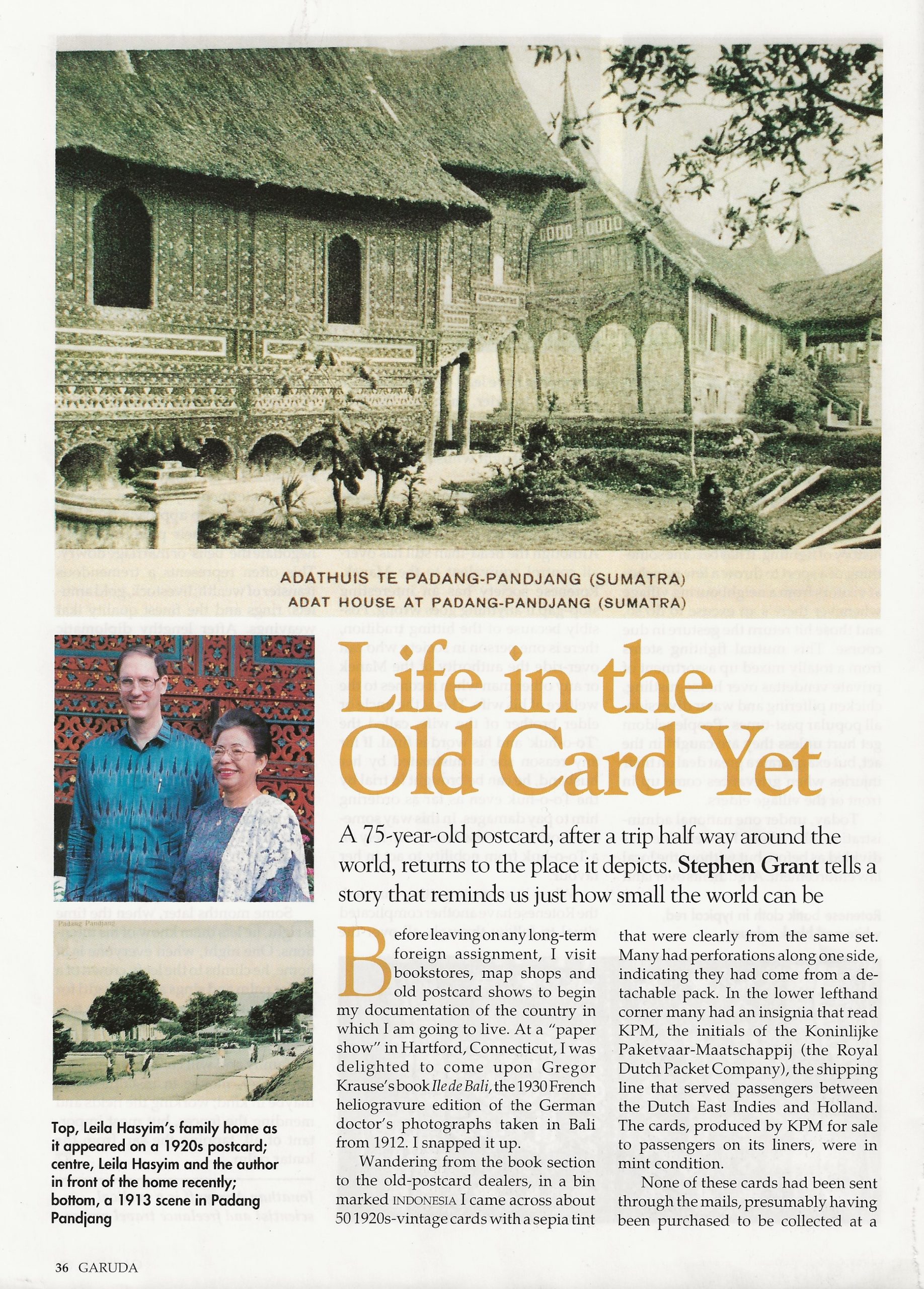

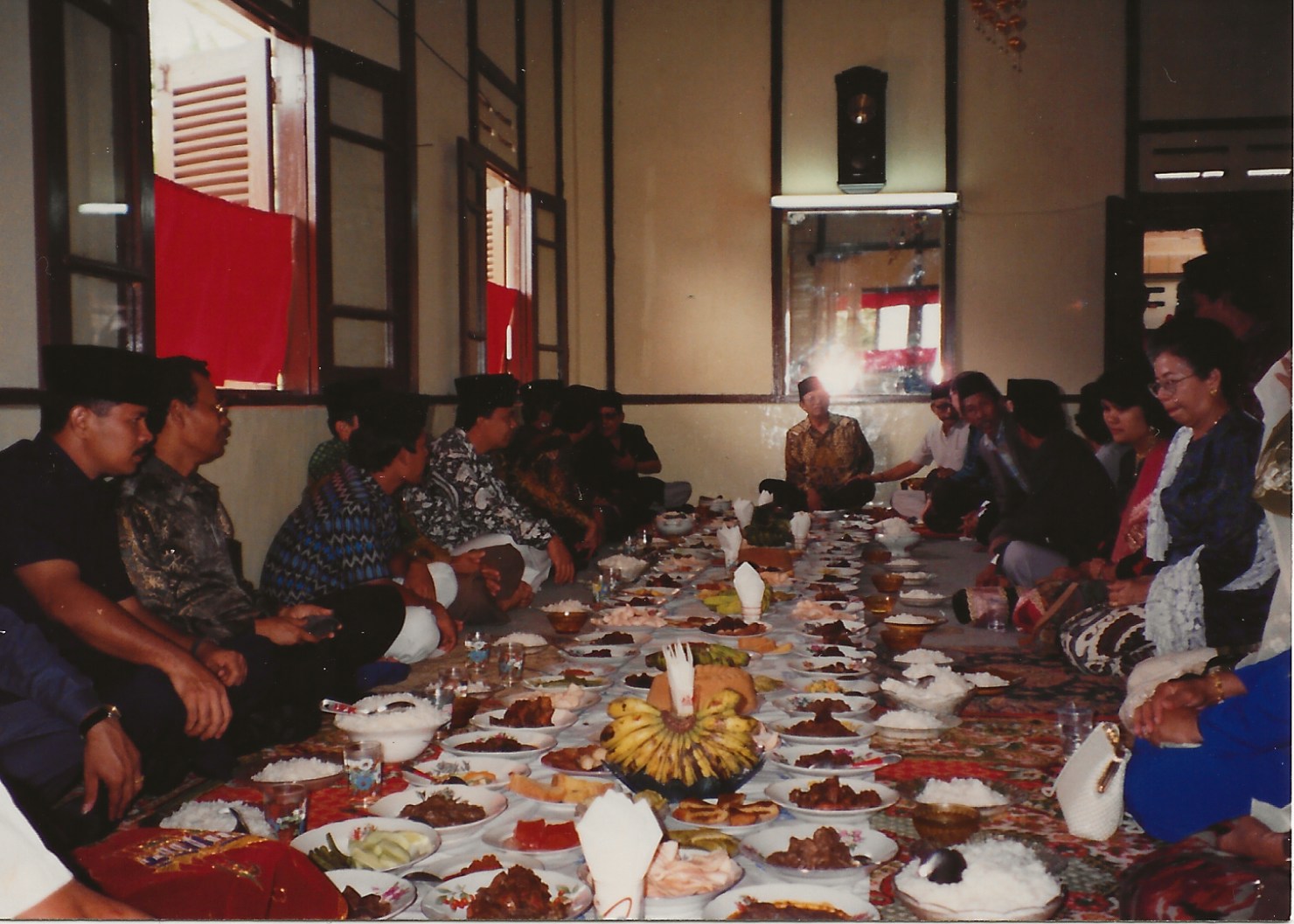
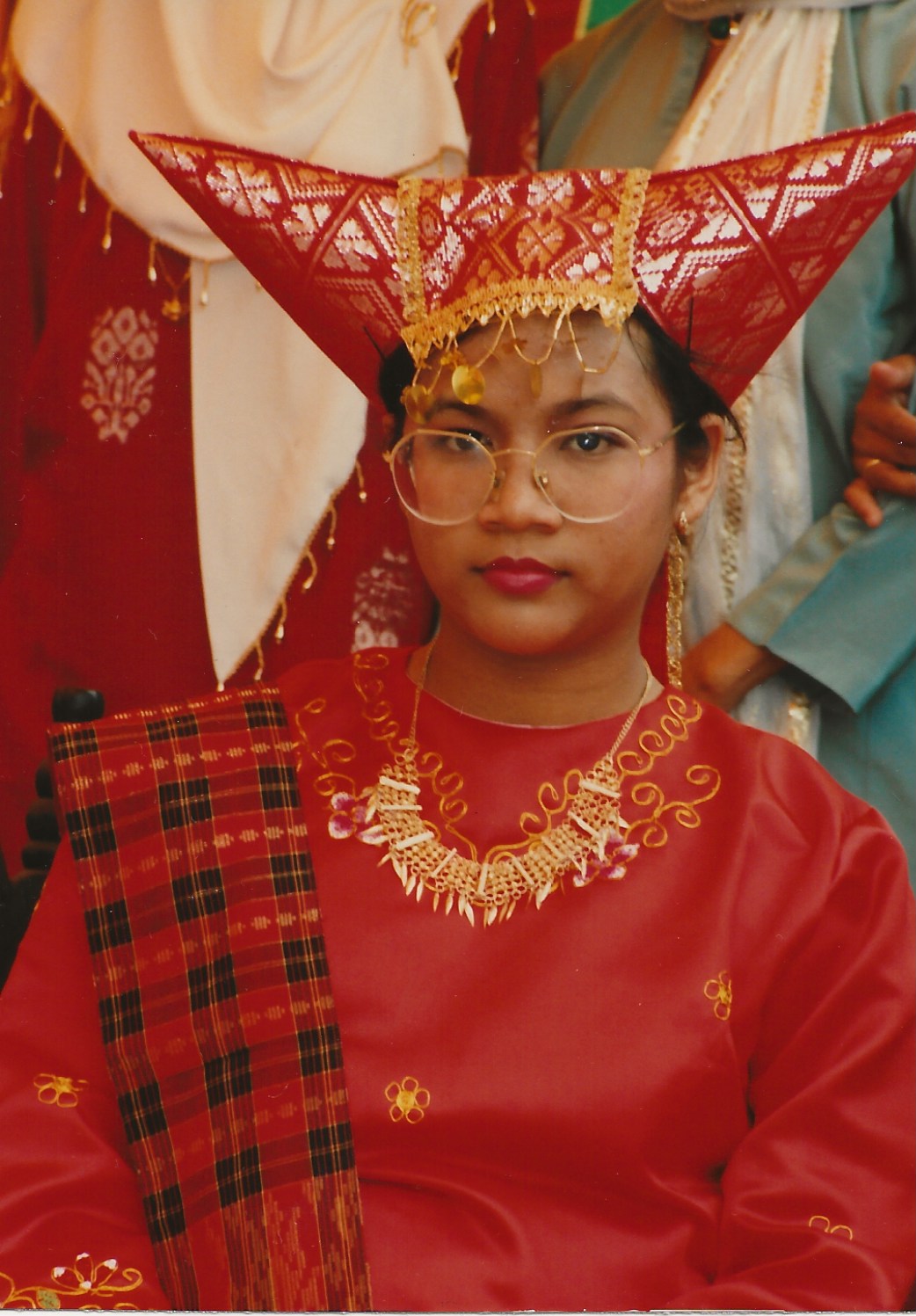
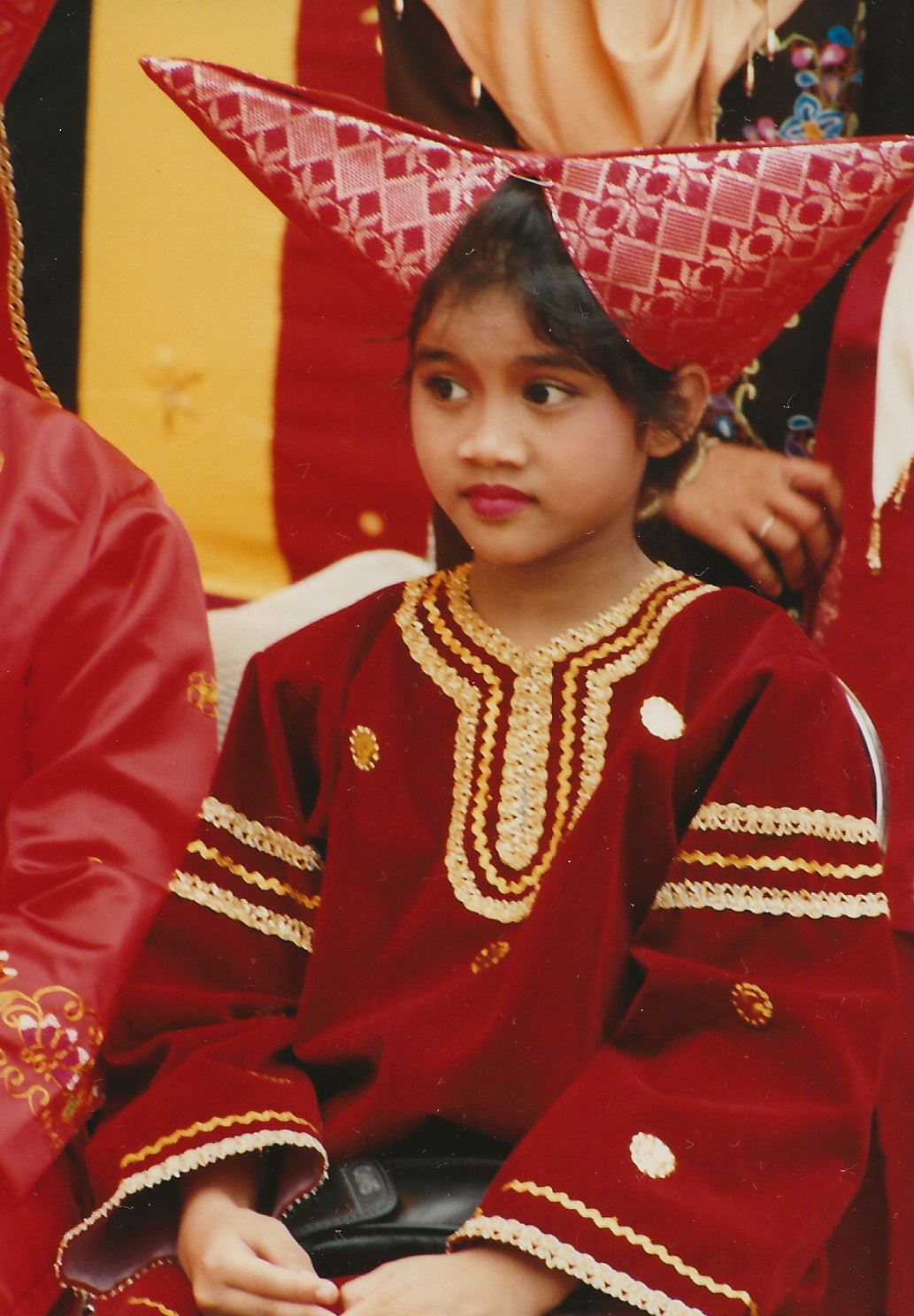
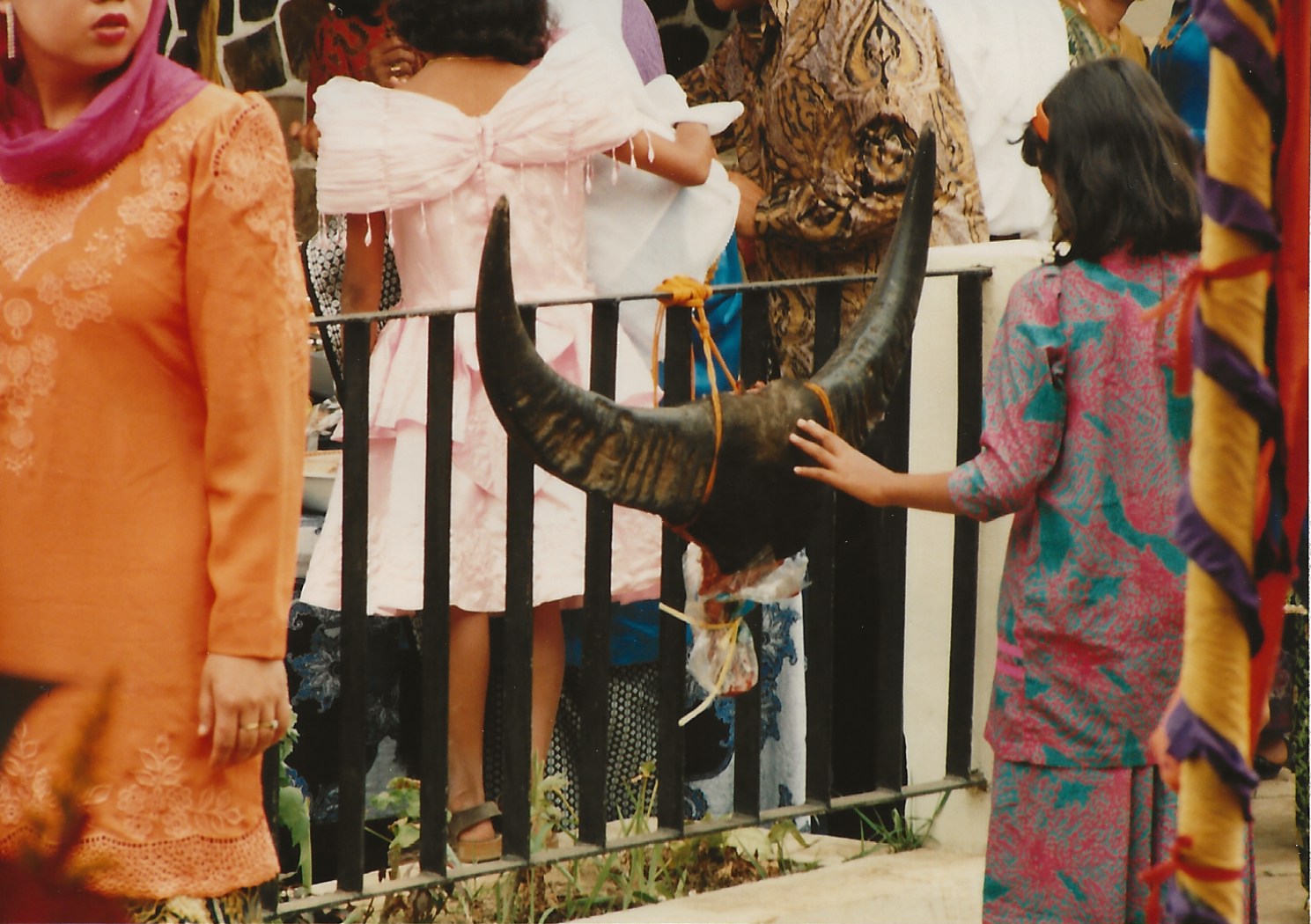
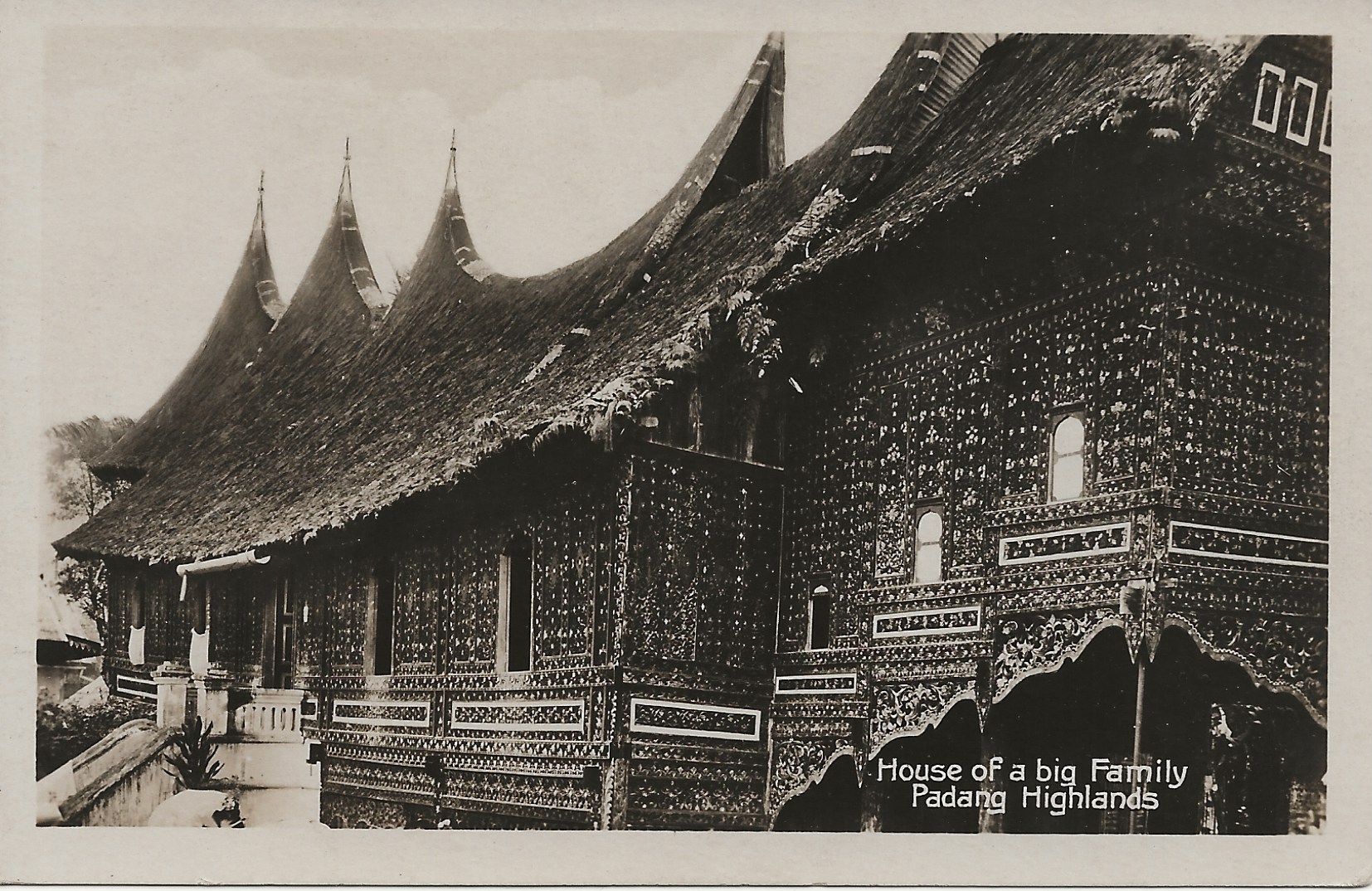
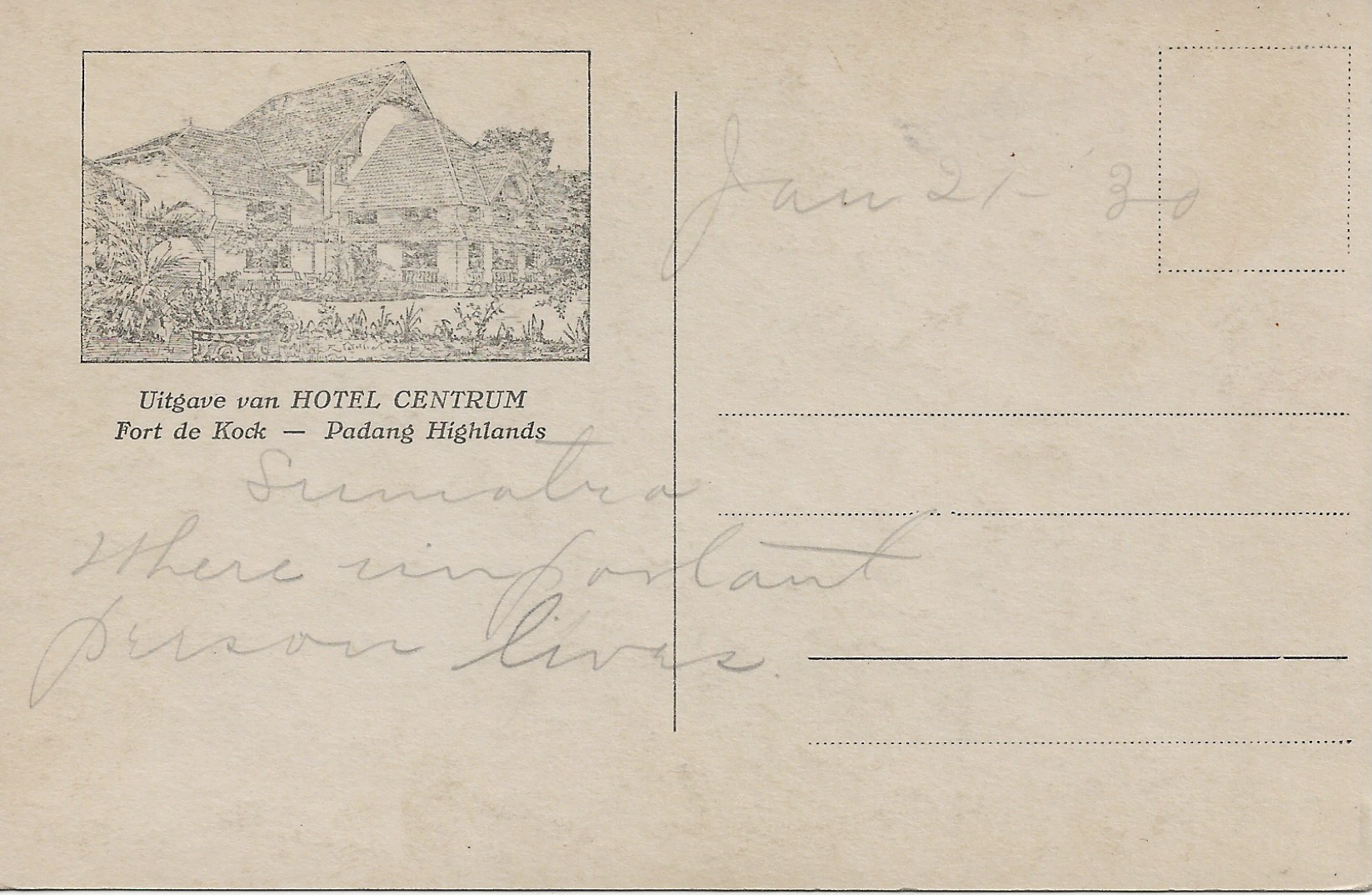
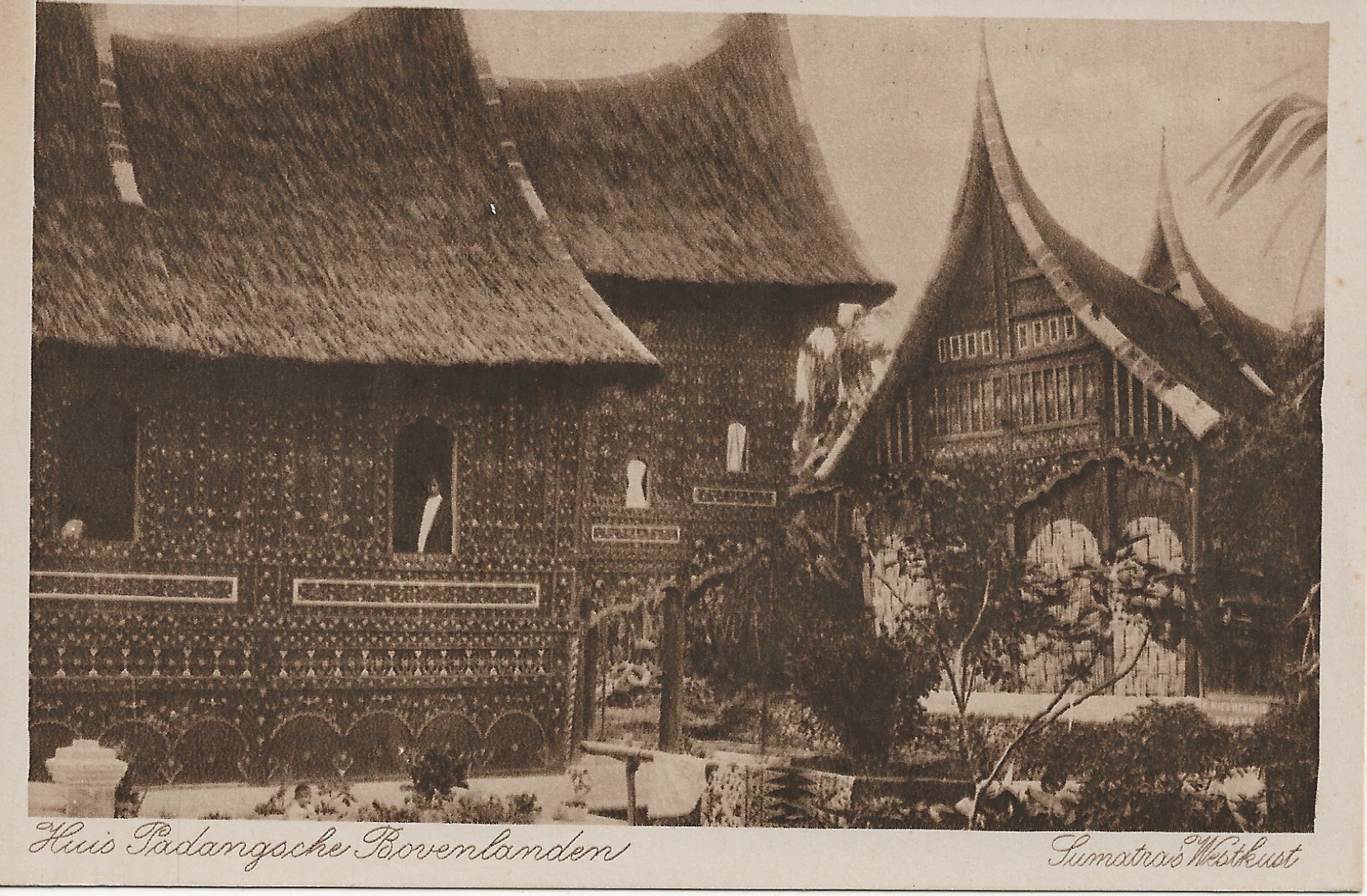
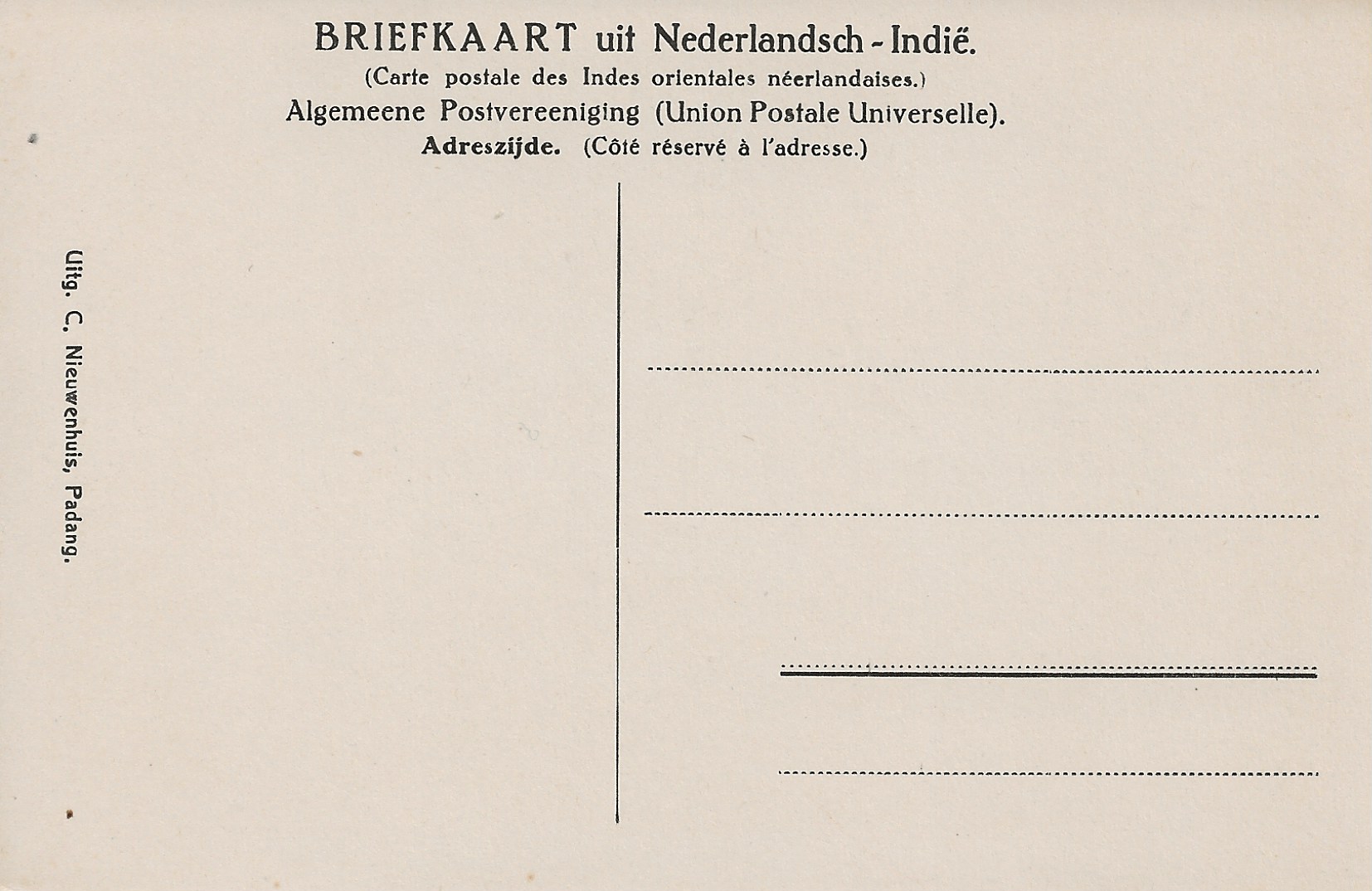
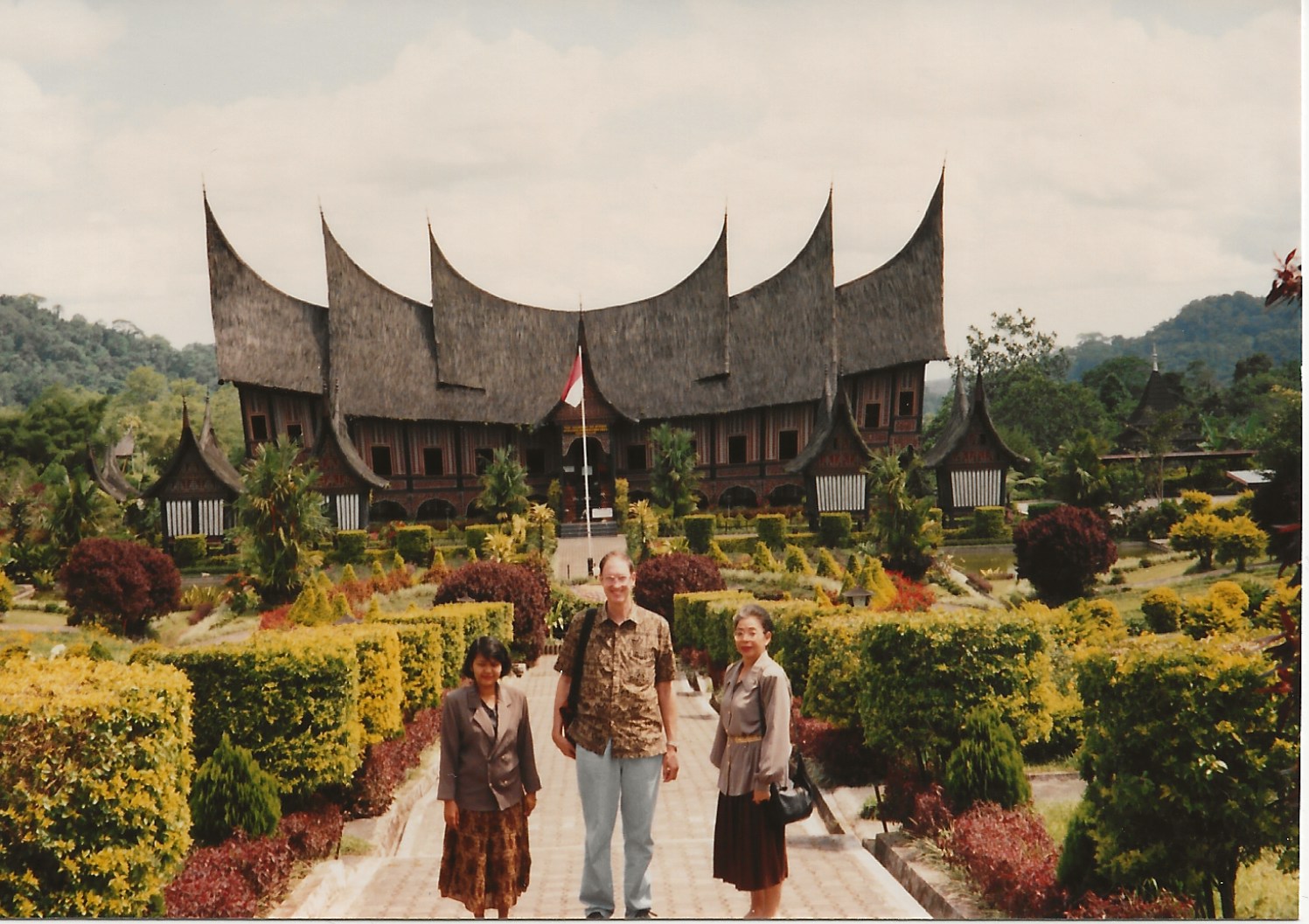
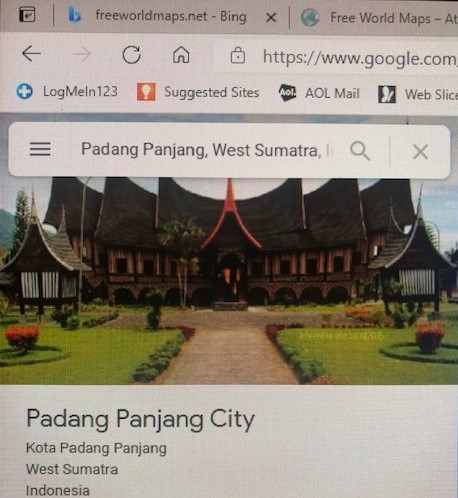
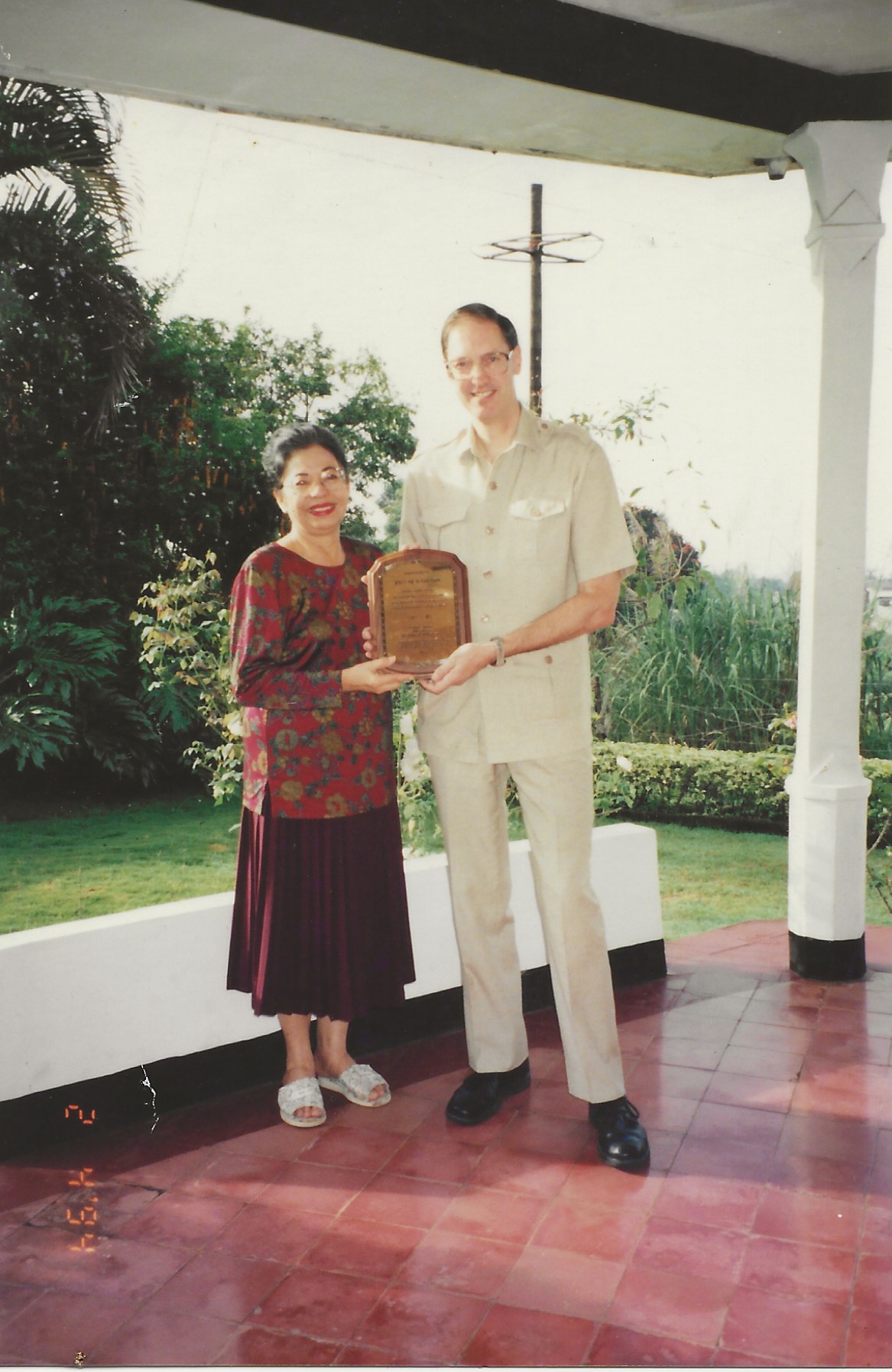
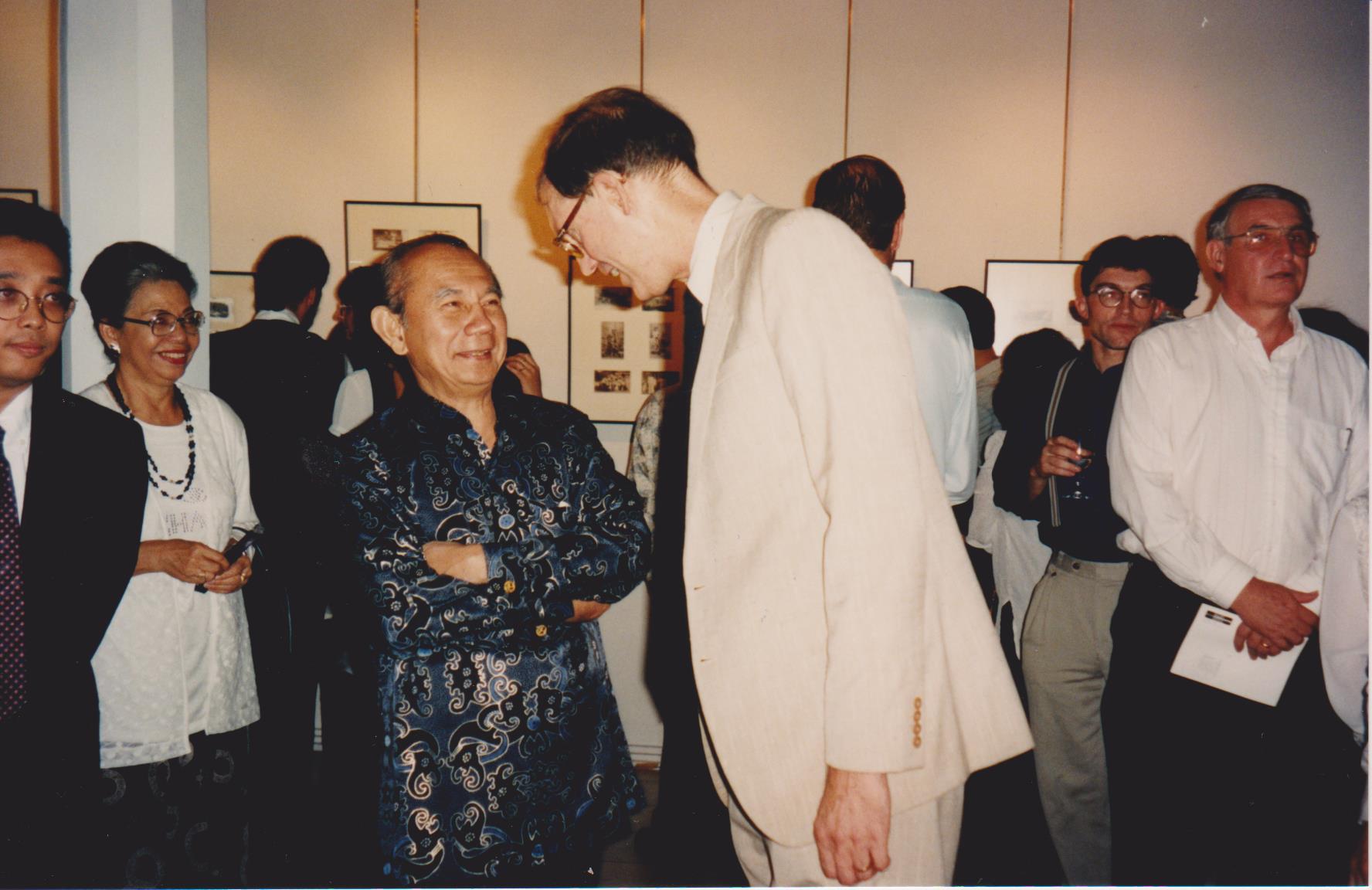
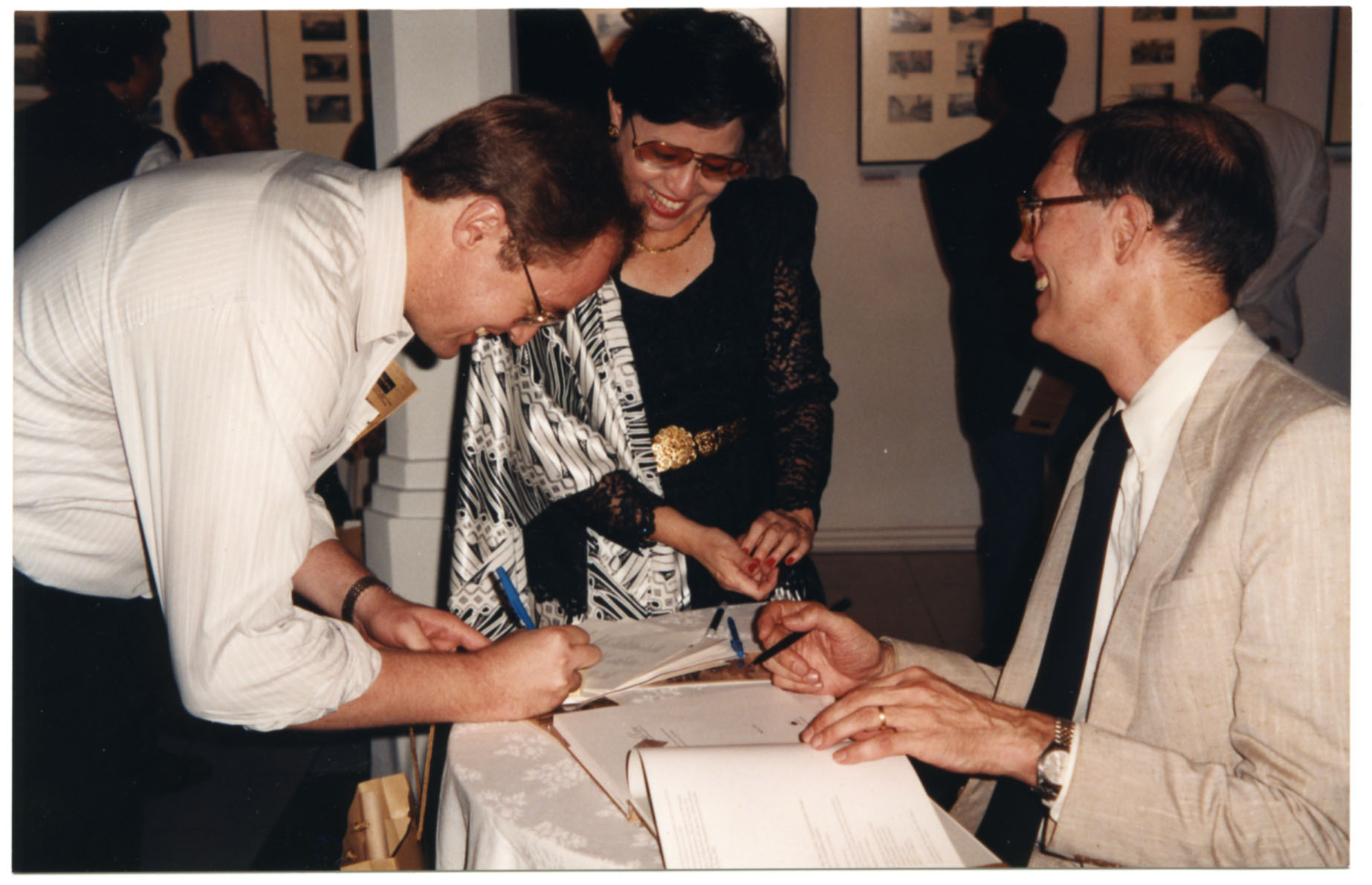
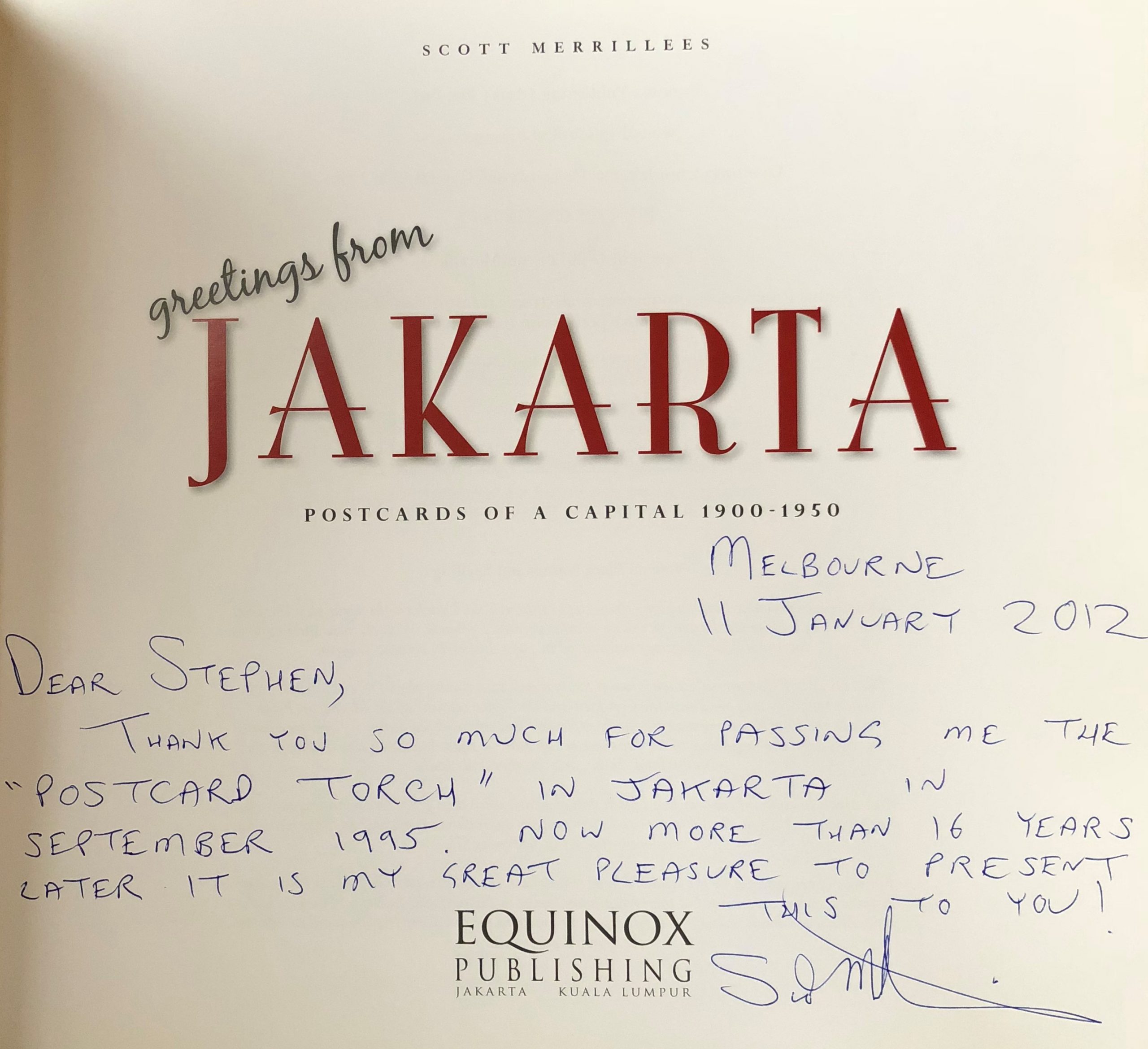
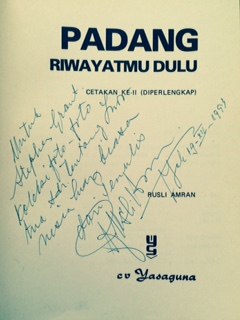
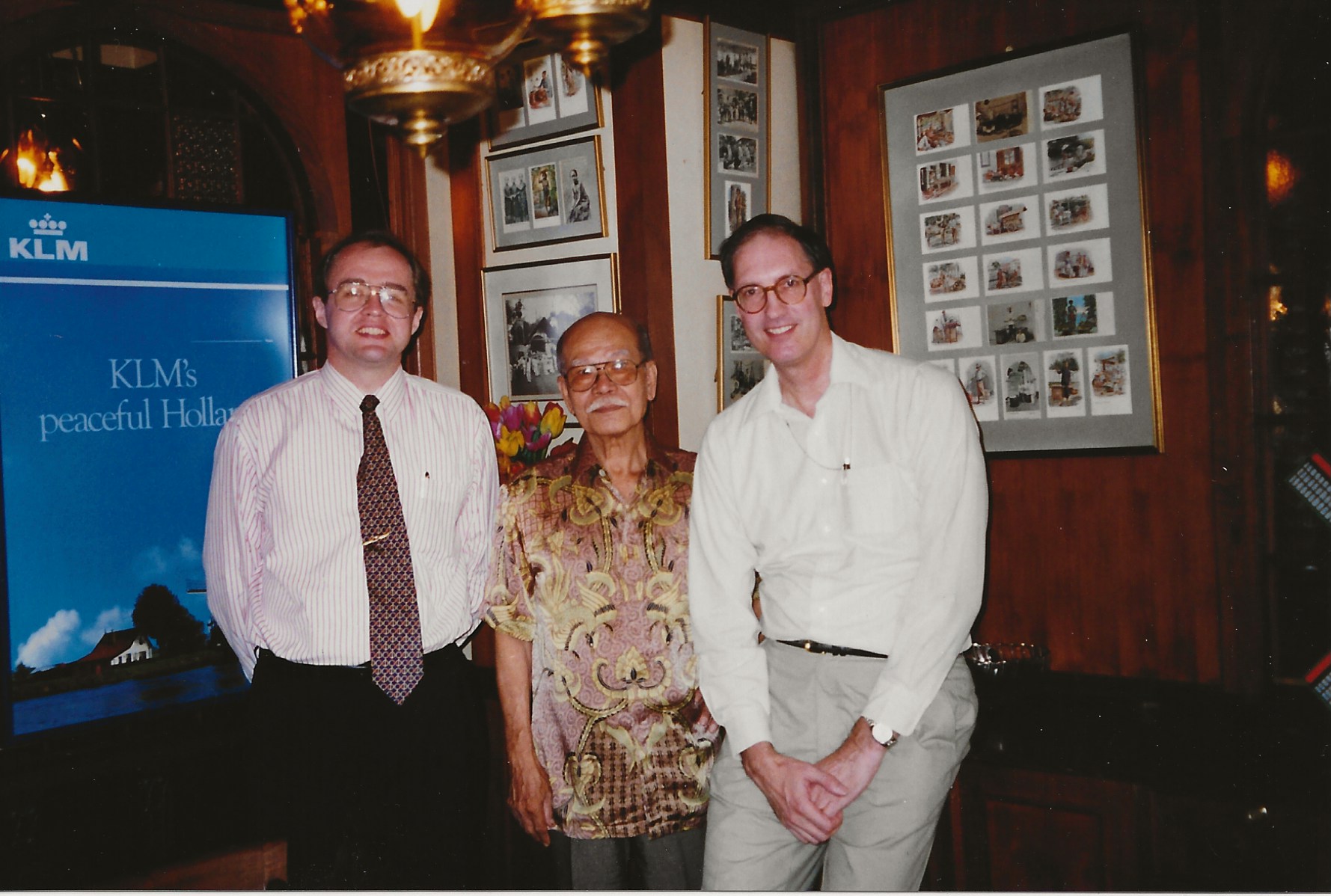
Best line: Rumah inI, rumah saya!
Once again Steven Grant has illuminated history in a manner that is under appreciated by historians. Postcards speak volumes and no one illustrates this better than Mr.Grant. As a fellow Diplomat (Consul General in Surabaya) I only wish I had kept a sharper eye out for postcards.
Dear Stephen, what a wonderful walk down memory lane. I love this blog posting thank you. A friend in Sydney alerted me to it. It all seems just like yesterday although I am older now (59) than you were then (55). I will contact you separately by email. Best regards, Scott
Please keep these fabulous postcards coming.
Wonderfully written.
Wonderful Steve
You are lucky to have a unique hobby and maintain it to date
My late father used to tell me “Stephen is very precise when questioning me about a postcard. This is exactly what one should be doing.”
I recall vividly him saying that.
I loved the article. The power of a postcard indeed. I have read about the Minangkabau and seen pictures of their houses, but you really brought it to life. I also loved the photos of the young women in the buffalo headdresses. How exciting for you to have lived there for 4 years.
Thanks for sharing this, Steve. I have your “Former Points of View” on my bookshelf and every once in a while, I pull it down and have a “walk” down those pathways of the past. You’ve made that possible, and I thank you!
Virgil
I was very happy when Stephen came to me with the idea for a book on Indonesian postcards and though “Former Points of View” is now long out of print the publication will forever be a pioneering and landmark work in the field of Indonesian deltiology. (I’m so glad that Scott Merrillees took the torch from Stephen and has produced additional and wonderful titles.)
Terima Kasih telah berkunjung ke kampung kami